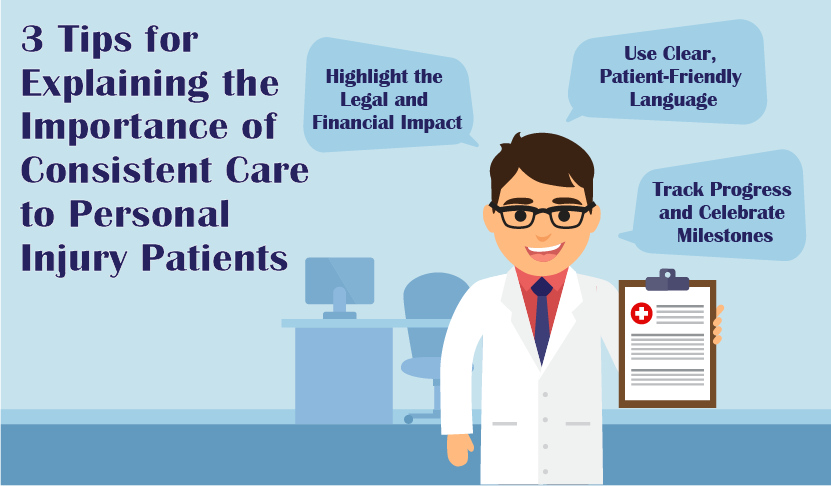When patients are recovering from an accident, it’s common for them to feel better after a few sessions and assume they no longer need care. However, consistency is key—not only for optimal recovery, but also for strengthening personal injury claims. Missed appointments or skipped treatments can slow healing, exacerbate injuries, and even raise questions from insurance companies.

Consistent care is one of the most important factors in supporting your patient’s case. Here are three practical tips to help you communicate this effectively:
1. Use Clear, Patient-Friendly Language
Patients may not fully understand how their body heals or why ongoing care is necessary. Explaining in plain, relatable terms can make a difference. For example, instead of only referencing medical jargon, you might say:
“Even though your pain is better, your muscles and joints are still recovering. Regular adjustments help prevent lingering issues or future flare-ups.”
Relating consistent care to long-term function—such as being able to return to work, exercise, or daily activities—makes the benefits tangible. Emphasizing that recovery isn’t always linear helps patients understand why sticking to the plan matters.
2. Highlight the Legal and Financial Impact
Many personal injury patients are motivated by understanding how their care affects their claim. Missed appointments or inconsistent treatment can be used by insurance adjusters to argue that the injury wasn’t serious or that care wasn’t necessary. Chiropractors can explain this without pressuring patients:
“Your follow-up visits help us document your progress and show that your treatment is medically necessary. This can make a difference if your insurance claim or settlement is being evaluated.”
Framing consistent care as both a medical and legal necessity encourages compliance and reassures patients that you’re working to protect their interests.
3. Track Progress and Celebrate Milestones
Patients are more likely to stay engaged when they see measurable results. Use objective assessments such as range of motion, pain scales, or functional tests to show improvement over time. Visual aids—charts, graphs, or simple progress summaries—can reinforce the value of each visit.
Celebrate milestones, even small ones, to maintain motivation. For instance:
“Your flexibility has improved by 20%, which means you’re on track to return to normal daily activities safely.”
When patients understand the connection between consistent care, recovery, and long-term outcomes, they are more likely to follow the plan and complete their treatment course.
Additional Considerations
Be empathetic when emphasizing continuity of care. Some patients may struggle with transportation, finances, or scheduling. Offering flexibility or home exercises can help maintain compliance. Additionally, keeping the legal team informed about progress and patient compliance ensures that everyone is aligned on treatment goals and documentation needs.
Consistent chiropractic care is essential for both recovery and supporting personal injury claims. By explaining treatment plans in clear language, connecting care to legal and financial outcomes, and tracking measurable progress, you help patients stay on track while reinforcing the value of your services.




